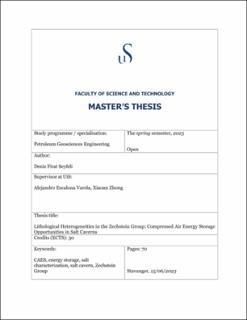| dc.description.abstract | Ensuring a sustainable future necessitates the adoption of renewable energy sources, such as wind and solar energy. However, these energy sources are inherently intermittent, which emphasizes the need for effective energy storage solutions. Among the various options available, compressed air energy storage (CAES) stands out as a cost-effective and practical mechanical storage approach suitable for large-scale implementation. In this context, underground salt caverns emerge as particularly favorable sites for energy storage due to their notable impermeability, high solubility, and low contamination rates. Accordingly, the objective of this study is to identify and characterize the Upper Permian salt formations within the Zechstein Group, located in the Norwegian sector of the Southern North Sea, with the aim of proposing an optimal reservoir location for creating salt caverns for the CAES applications.
The study investigated a comprehensive collection of subsurface data, which includes a 3D seismic cube spanning an area of 3070 km2, over 140 kilometers of 2D seismic lines, and multiple borehole data encompassing well tops, logs, reports, etc. Well data were mainly sourced from the Diskos database of the Norwegian Petroleum Directorate (NPD), which ensured the reliability and accuracy of obtained information. Industry-standard software tools such as Landmark DecisionSpace and SLB Petrel were employed for data analysis, structural interpretation, geological mapping, and 3D visualization.
Various salt structures within the Zechstein Group were successfully identified and classified. Three maps in two-way travel time (TWT) domain were generated after seismic interpretation, including the top and base Zechstein Group structural map and the thickness of the Zechstein Group. These maps aided in both spatial distribution and the geometry of salt structures. To understand the internal structures and heterogeneity of these salt structures, five facies were classified by integrating seismic amplitudes, borehole log responses, and the observation of conventional cores from nearby reference wells. Three-dimensional facies models were constructed for two selected salt diapirs. Two halite-rich facies are suggested for creating caverns in salt diapirs due to relatively homogeneous lithology within structureless or chaotic geo-bodies. Above findings from this study were ultimately utilized to propose an optimal location for the criterion of salt caverns, thereby facilitating efficient CAES operations. | |
